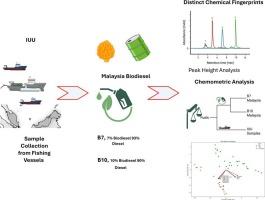Forensic differentiation of Malaysia biodiesel and illicit fuels using GC-FID and GC–MS techniques
IF 7.5
1区 工程技术
Q2 ENERGY & FUELS
引用次数: 0
Abstract
Illegal, unreported, and unregulated (IUU) fishing poses a serious threat to marine biodiversity and economic stability, particularly in coastal nations like Malaysia, where the smuggling of government-subsidized fuel is often linked to IUU activities. This study presents a forensic approach using gas chromatography-flame ionization detection (GC-FID) and gas chromatography-mass spectrometry (GC–MS) to chemically characterize and differentiate between legally distributed Malaysia biodiesel blends (B7 and B10) and illicit fuels seized from vessels involved in maritime violations. A total of 29 fuel samples from detained vessels in Kuala Terengganu and Mersing were compared with 20 reference biodiesel samples from major Malaysia fuel brands. GC-FID revealed hydrocarbon ranges of C10–C29 in biodiesel, with additional FAME peaks near n-C19 and n-C21, while IUU fuels showed wider ranges (C10–C33) but no FAMEs. GC–MS confirmed key biomarkers—bicyclic sesquiterpanes, adamantanes, isoprenoids, PAHs, and FAMEs—highlighting methyl palmitate (C16:0) and methyl oleate (C18:1) as diagnostic of biodiesel. Multivariate analyses (HCA and PCA) further separated B7, B10 and IUU samples, with subtle differences between B7 and B10 attributed to feedstock or blending variation. This study is the first to combine GC-FID, GC–MS, and chemometric analyses (PCA and HCA) into a forensic framework for differentiating Malaysian biodiesel blends (B7, B10) from illicit maritime fuels. By leveraging diagnostic biomarkers beyond FAMEs, the approach enables robust classification and provenance analysis. This integrated strategy provides evidential value for maritime law enforcement, advancing fuel forensics in Southeast Asia. These findings display the utility of chromatographic techniques in maritime law enforcement, enabling fuel source attribution and supporting legal proceedings. Despite promising results, limitations such as restricted sample coverage, lack of replicate analysis, and absence of a chromatographic fingerprint database highlight the need for further validation. The study advocates for the development of an integrated GC-based forensic framework to enhance Malaysia’s capability in combatting fuel smuggling and IUU fishing activities.

使用气相色谱- fid和气相色谱-质谱技术鉴别马来西亚生物柴油和非法燃料
非法、不报告和不管制(IUU)捕鱼对海洋生物多样性和经济稳定构成严重威胁,特别是在马来西亚等沿海国家,政府补贴的燃料走私往往与IUU活动有关。本研究提出了一种法医方法,使用气相色谱-火焰电离检测(GC-FID)和气相色谱-质谱分析(GC-MS)来化学表征和区分合法销售的马来西亚生物柴油混合物(B7和B10)和从涉及海事违法行为的船只上查获的非法燃料。在吉隆坡登嘉楼和默兴岛被扣留船只的29个燃料样本与来自马来西亚主要燃料品牌的20个参考生物柴油样本进行了比较。GC-FID显示生物柴油中C10-C29的碳氢化合物范围,在n-C19和n-C21附近有额外的FAME峰,而IUU燃料的范围更广(C10-C33),但没有FAME峰。GC-MS确认了关键的生物标志物——双环倍半萜烷、adamantanes、异戊二烯类、PAHs和fames——突出了棕榈酸甲酯(C16:0)和油酸甲酯(C18:1)作为生物柴油的诊断指标。多变量分析(HCA和PCA)进一步分离了B7、B10和IUU样品,B7和B10之间的细微差异归因于原料或混合变化。这项研究首次将GC-FID、GC-MS和化学计量分析(PCA和HCA)结合到一个法医框架中,用于区分马来西亚生物柴油混合物(B7、B10)和非法海上燃料。通过利用FAMEs以外的诊断性生物标志物,该方法可以实现稳健的分类和来源分析。这一综合战略为海事执法提供了证据价值,推进了东南亚的燃料取证工作。这些发现显示了色谱技术在海事执法中的效用,使燃料来源归属和支持法律诉讼。尽管结果很有希望,但局限性,如有限的样品覆盖范围,缺乏重复分析,缺乏色谱指纹数据库,突出了进一步验证的必要性。该研究报告主张发展一个综合的基于gc的法医框架,以提高马来西亚打击燃料走私和IUU捕鱼活动的能力。
本文章由计算机程序翻译,如有差异,请以英文原文为准。
求助全文
约1分钟内获得全文
求助全文
来源期刊

Fuel
工程技术-工程:化工
CiteScore
12.80
自引率
20.30%
发文量
3506
审稿时长
64 days
期刊介绍:
The exploration of energy sources remains a critical matter of study. For the past nine decades, fuel has consistently held the forefront in primary research efforts within the field of energy science. This area of investigation encompasses a wide range of subjects, with a particular emphasis on emerging concerns like environmental factors and pollution.
 求助内容:
求助内容: 应助结果提醒方式:
应助结果提醒方式:


